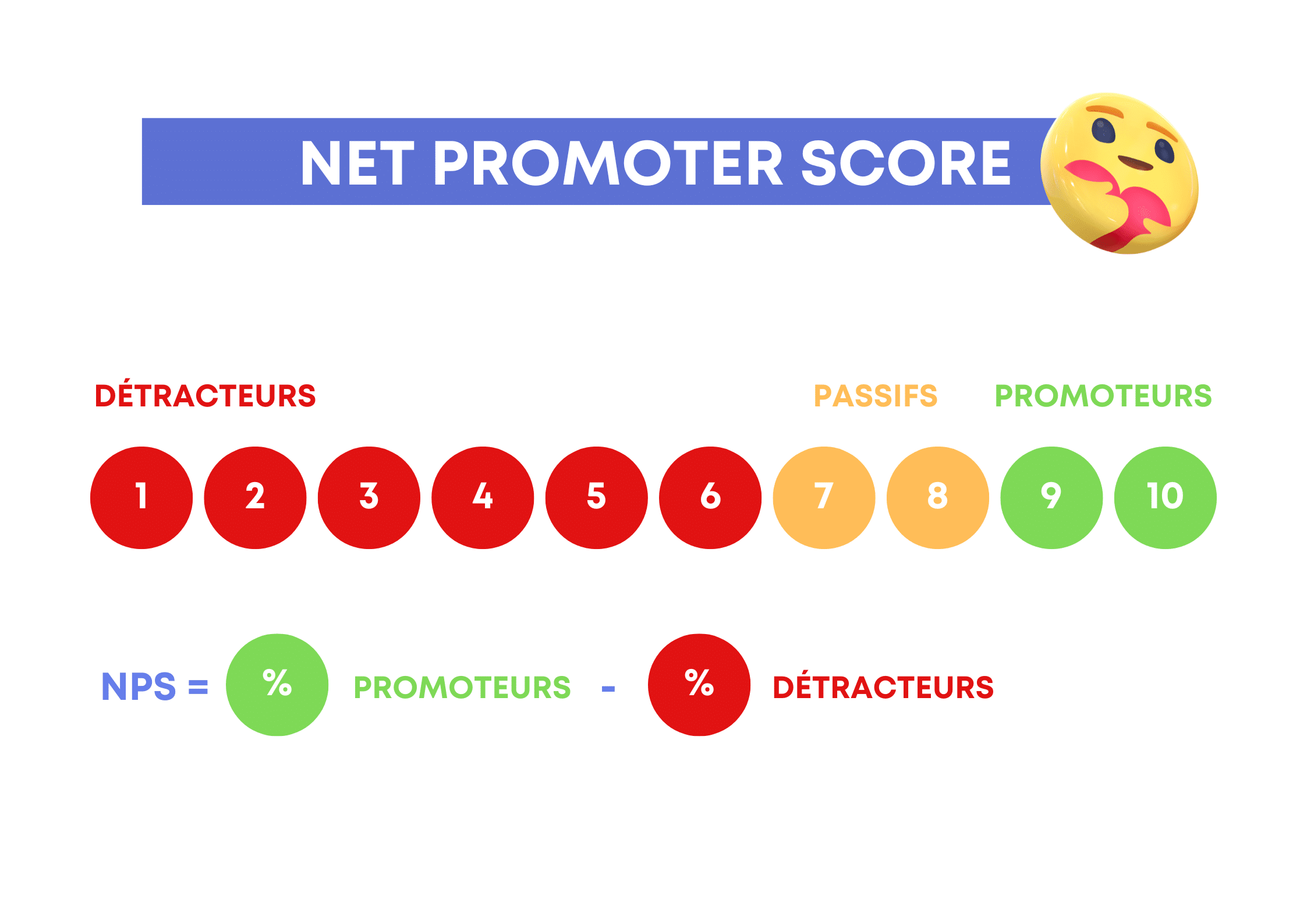We all know how important customer satisfaction is today. But do you know how to measure it? 📏 That’s exactly what the NPS or Net Promoter Score is for.
This refers to a marketing metric that’s very useful for understanding customer satisfaction. 🥰 With this article, find out if your customers are satisfied with your product or service!
What is NPS? Net Promoter Score Definition
NPS stands for Net Promoter Score. 👌 It is a metric used in customer marketing to and analyze responses and determine the satisfaction rate (CSAT) of consumers of a product or customers of a brand.
More specifically, NPS is used to determine whether a customer is a promoter or detractor of a company. 👉 This KPI measures the percentage of customers who recommend or criticize your company to their network (both personally and professionally).
In most cases, the Net Promoter Score is measured using a question formulated as follows:
« On a scale of 1 to 10, would you recommend [X] to your friends and family? »
Respondents indicate a score from 1 to 10, allowing them to be assigned to one of three groups:
- Detractors (scores from 1 to 6),
- Passive (scores from 7 to 8),
- Promoters (score from 9 to 10).
NPS scores help companies improve customer service, products or delivery to increase customer loyalty. 💘
Who are the detractors? (Notes 1 to 6)
Detractors are customers and users who respond on a scale of 1 to 6. This scale is the broadest in the NPS spectrum. Consequently, it generally brings together all those who are dissatisfied, or even disappointed or angry. 😤
This group of customers should not be taken lightly, as they can cause serious damage to a brand’s image, including complaints, negative word-of-mouth and a « bad reputation » on social networks. 🙊
For this reason, you need to identify your detractors quickly. 💡 Then identify the problem and try to solve it as far as possible.
Liabilities (Notes 7 to 8)
Passives (also called neutrals) are customers and users who answer 7 or 8. ✅ They are satisfied overall, but not enough to become promoters.
This is why they have a more passive attitude. They are often the least represented part of the NPS 👉 (the more polarized people are, both positively and negatively, the more likely they are to respond).
Make no mistake, though 7 and 8 are good scores. 💡 This customer category is easily won over by competitors. So you need to work on how to retain them with loyalty programs, for example.
Who are the Promoters? (Notes 9 to 10)
Promoters are customers and users who answer 9 or 10 🤩 These are the people most loyal to your company.
They are highly satisfied with your products and services, and serve as brand ambassadors. 💘 This means they regularly promote your company to their network.
Very often, these customers like your brand for emotional and identity reasons (in addition to rational ones). 🧠 Scores in the Promoter category are intentionally high to ensure that these customers really are fans of your product/service.
Here is an example of NPS scores, to better illustrate what we are saying: ⏬

Why track the NPS KPI?
The NPS KPI is an indicator used to evaluate and compare brand image, its real value lies in the answers you get from more detailed satisfaction questionnaires. 👂
Add open-ended questions such as « What are the main reasons for your score? » and « How can I improve my business and my score? » or investigate complaints from dissatisfied customers.
By doing so, you can discover new opportunities for improvement.
For even greater efficiency, combine Net Promoter Score analysis with other customer satisfaction measurement tools such as CSAT or CES (Customer Effort Score). ✍️
How to calculate NPS? Net Promoter Score Calculation
To calculate your company’s NPS score, subtract the percentage of Detractors from the percentage of Promoters (Passives are not included in the calculation): 👇
Net Promoter Score = % Promoters – % Detractors
For example, we can say that your NPS is 10 when you have 30% Promoters and 20% Detractors. 💡 Of course, the higher your NPS, the better your brand image.
Why calculate NPS?
NPS can be used as a measure to predict business growth. 🚀 A high score indicates that customers are not only satisfied with your business, but are also willing to make a recommendation to others.
While a valuable measure at a strategic level, this score is not sufficient to paint a complete picture of the state of customer relations. 🤝
What is a good NPS?
A score above 30 can be considered good for a company. 💯 This means that the number of people willing to recommend the brand is greater than the number of people who have bad things to say.
Typically, large companies have a score of around 50. 👏 To succeed at such a level, you have to do everything you can to ensure that the number of promoters far outnumbers the number of detractors.
NPS scores can be interpreted as follows: ⏬
- 0: The majority of people who interact with your product or brand have a bad experience. 😢 They’re not happy with your company and spread the message that your products and services should be avoided.
- 1-30: This is an acceptable score, as there are slightly more promoters than detractors. 👍 However, most companies in this case are working to improve in many areas.
- 31-50: Most companies are here. ✅ Companies with this score focus on a high-quality customer experience and usually succeed thanks to a strong group of promoters who support their brand.
- 51-70: Companies with this score focus primarily on the customer experience, and it pays off. 💎 Some of the most popular brands have NPS in this range. This means they have a larger-than-average group of promoters.
- 71-100: This is the ultimate Net Promoter Score 🏔️ and it’s rarely achieved. Companies that achieve results like this are considered among the best in their sector.
How can you improve your Net Promoter Score?
To improve it, companies need to focus on enhancing the customer experience. 🤗 This means actively listening to customer feedback, identifying and resolving specific issues that hinder satisfaction.
It’s important to create a positive, memorable customer experience through high-quality service and personalized interactions. 🎨 Encouraging and facilitating the exchange of positive feedback also plays an important role.
Ultimately, interacting regularly with customers, acting on their suggestions and being upfront about improvements builds trust and loyalty, which helps improve your score. 🙏

How to conduct an NPS survey
To conduct an effective NPS survey or poll, it’s important to structure it in such a way as to capture accurate, actionable data. 💥
- First, consider demographic questions such as age, gender, location and employment status.
- This information helps you segment your results and identify trends specific to specific customer groups. 📊
- Next, we introduce the key NPS questions. 👉 « On a scale of 0 to 10, how likely is it that you would recommend our company/product/service to a friend or colleague? »
- This question is at the heart of these surveys 💖 and is designed to directly measure customer loyalty. Then ask an open-ended question asking the reason for the rating.
- This gives respondents the opportunity to explain in detail why they chose this rating, and provides valuable insights into areas that need improvement or are working well. 💫
- Ask questions about how we can improve the customer experience and ask for specific suggestions to make your services and products even better. 🥇
- Finally, ask permission to contact the customer again to expand on their response or thank them for their participation. 🙌
This last step is important to demonstrate that your customers’ opinions are valued and form a solid basis for future improvements.
Conclusion: The usefulness of Net Promoter Score
Net Promoter Score (NPS) is a valuable tool for measuring customer satisfaction and loyalty to your brand or service. 🤔
NPS surveys are used to measure customer perceptions directly, simply by asking them how likely they are to recommend your company.
This simplicity of asking a customer a question makes it easy to collect data and interpret results, enabling companies to quickly identify areas for improvement. 👉 NPS is much more than just a « score ».
It acts as a barometer of the quality of a company’s relationship with its customers, indicating the level of commitment and satisfaction. 💹
By focusing on improving NPS, companies can deploy targeted actions that enhance experiences, increase customer loyalty and, ultimately, drive organic growth through positive word-of-mouth. 👄
In short, it’s a strategic tool ⚡ for improving a company’s overall performance.
Article FAQ
How do you say « Net Promoter Score »?
Net Promoter Score literally means « Net Promoter Score ». 🤓 However, as is often the case with marketing abbreviations, the French translation is rarely used.
What’s more, the purpose of NPS is to calculate the percentage of customers who promote your company. ✔️
What is CSAT?
The CSAT satisfaction rate (or « Customer Satisfaction Score ») is a metric used to assess the level of customer satisfaction 📊 with a product, service or other specific experience offered by a company.
Generally, to measure it, customers are asked to express their satisfaction on a scale, often from 1 to 5, where :
- 1 indicates complete dissatisfaction. 🔴
- 5 indicates total satisfaction. 🟢
This score is a key performance indicator 🔑 for companies, as it gives an immediate insight into how customers perceive and experience their brand.
What is CES?
CES (or « Customer Effort Score ») is a measure of the effort required by a customer to receive a solution to a request or problem solved by a company.
CES is usually measured by simple questions such as :
« On a scale of 1 to 7, how easy was it to solve your problem today? »
and helps companies understand the effectiveness of their customer service. ☎️
A low score indicates a high level of effort, which can lead to customer dissatisfaction, while a high score indicates a smooth, satisfying experience, favoring customer loyalty and retention.
Now you know all about the Net Promoter Score or NPS 😉













